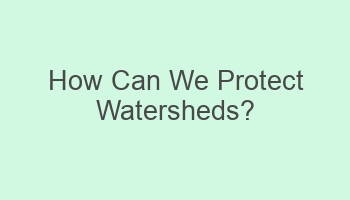How Can We Protect Watersheds?

Protecting watersheds is crucial for ensuring clean water sources for communities. Watershed protection involves implementing strategies to prevent pollution and preserve natural habitats. By understanding the importance of watershed conservation, individuals and communities can take action to safeguard these vital resources. This article will explore how we can protect watersheds through proper land management, reducing runoff, and promoting sustainable practices. Strategies such as protecting riparian zones and implementing stormwater management plans are essential in protecting watersheds from degradation. By following these guidelines, we can contribute to the protection of watersheds for future generations.
Contents
| Plant trees along rivers to prevent erosion and filter pollutants. |
| Use eco-friendly products to reduce chemical runoff into watersheds. |
| Implement rain gardens to absorb and filter stormwater runoff. |
| Reduce pesticide and fertilizer use to protect water quality in watersheds. |
| Support legislation that protects watersheds from pollution and development. |
- Volunteer for cleanup events to remove trash and debris from watersheds.
- Monitor and report any pollution or illegal dumping in watersheds.
- Collaborate with community groups to educate others on watershed conservation.
- Participate in restoration projects to improve the health of watersheds.
- Engage in advocacy efforts to promote policies that protect watersheds.
Why is Watershed Protection Important?
Watershed protection is crucial for maintaining clean and healthy water sources. A watershed is an area of land where all the water that falls within it drains into a common water body, such as a river, lake, or ocean. By protecting watersheds, we can preserve water quality, protect habitats, and sustain biodiversity.
- Prevents erosion and sedimentation
- Reduces pollutants entering water bodies
- Ensures a sustainable supply of clean water
What are Some Ways to Protect Watersheds?
Protecting watersheds involves a combination of conservation practices and regulatory measures. Some effective ways to protect watersheds include reducing runoff, restoring riparian areas, and implementing best management practices.
| Planting native vegetation | Implementing erosion control measures |
| Managing stormwater runoff | Minimizing pesticide and fertilizer use |
When Should Watershed Protection Efforts Begin?
Initiating watershed protection efforts should start as early as possible to prevent further degradation of water quality. It is essential to address watershed issues proactively and involve stakeholders in the decision-making process.
- During the planning and development phase of projects
- As soon as potential threats to watersheds are identified
Where Can I Learn More About Watershed Protection?
Learning about watershed protection can be done through educational programs, online resources, and community workshops. Organizations such as watershed associations and environmental agencies provide valuable information on best practices for watershed protection.
| Attending watershed conservation events | Participating in volunteer projects |
| Engaging with local watershed management plans | Accessing online watershed protection toolkits |
Who Can Help Implement Watershed Protection Measures?
Implementing watershed protection measures requires collaboration among various stakeholders, including government agencies, nonprofit organizations, and community members. Working together can enhance the effectiveness of watershed protection efforts.
- Local governments and municipalities
- Environmental organizations and advocacy groups
How Can Watershed Protection Benefit the Environment?
Protecting watersheds can have positive impacts on the environment by conserving natural resources, promoting habitat restoration, and reducing pollution levels. By safeguarding watersheds, we can preserve ecosystem balance and support wildlife populations.
| Improving water quality and clarity | Enhancing biodiversity and ecosystem resilience |
| Creating recreational opportunities for communities | Mitigating the impacts of climate change |
What Role Does Legislation Play in Watershed Protection?
Legislation plays a crucial role in enforcing regulations and guidelines that govern watershed protection practices. Laws such as the Clean Water Act and local ordinances help protect water quality and preserve natural habitats.
- Regulating industrial discharges and pollution sources
- Establishing buffer zones along water bodies
Which Industries Pose the Greatest Threat to Watersheds?
Certain industries can pose significant threats to watersheds due to pollutant discharges and habitat destruction. Industries such as agriculture, mining, and construction must implement sustainable practices to minimize their impact on watersheds.
| Proper waste management and recycling | Using eco-friendly technologies and materials |
| Adopting erosion control measures | Participating in watershed restoration projects |
How Can Individuals Contribute to Watershed Protection?
Individuals can make a significant impact on watershed protection by adopting sustainable practices in their daily lives. Actions such as conserving water, reducing pollution, and supporting local conservation efforts can help preserve and restore healthy watersheds.
- Properly disposing of household chemicals
- Participating in river clean-up events